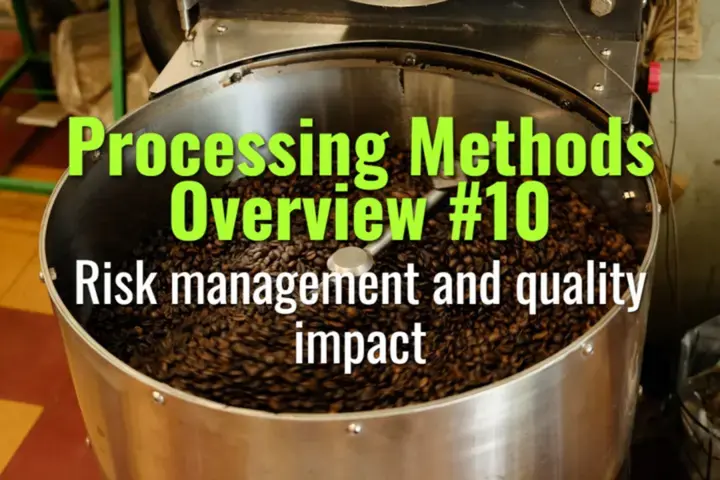Risk management and quality impact
This topic explains the risks involved in coffee processing, how they affect quality, and the strategies producers use to minimize defects while maximizing flavor potential.
- Coffee Basics Nerds
- 2 min read
Article 10 of 12 in Processing Methods Overview/

Why Risk Management is Crucial
- Processing is one of the most critical stages in determining final cup quality.
- Errors at this stage can permanently reduce value, regardless of cultivar or terroir.
- Effective risk management safeguards both farmer income and market reputation.
Main Processing Risks
1. Fermentation Risks
- Over-fermentation: Sour, alcoholic, or vinegar-like flavors.
- Under-fermentation: Sticky mucilage, uneven drying, dirty cups.
- Contamination: Undesirable microbes causing mold or phenolic defects.
2. Drying Risks
- Uneven drying: Beans at different moisture levels → inconsistency.
- Over-drying: Brittle beans prone to breakage.
- Under-drying: Mold growth, storage instability.
- Rain during drying: Leads to defects and flavor taints.
3. Storage Risks
- Poor storage: Exposure to humidity, pests, or odors.
- Inadequate ventilation: Condensation and mold risk.
- Long-term degradation: Loss of aroma and increased flatness.
4. Infrastructure & Labor Risks
- Insufficient drying beds/patios → overcrowding and uneven lots.
- Labor shortages → delayed picking and processing.
- Lack of training → mishandling of equipment.
Quality Impacts of Poor Risk Management
- Physical defects: Black beans, broken beans, insect damage.
- Sensory defects: Musty, phenolic, sour, or dirty flavors.
- Market consequences: Lower cupping scores, downgraded lots, financial losses.
Risk Management Strategies
- Monitoring: Regular checks of temperature, pH, and moisture content.
- Sanitation: Clean tanks, patios, and equipment to avoid contamination.
- Controlled drying: Use raised beds, solar dryers, or mechanical dryers when needed.
- Sorting: Remove defective cherries before processing.
- Storage practices: Use jute bags with GrainPro liners; store in cool, dry, ventilated warehouses.
- Training: Educate workers on best practices and risk awareness.
Linking Risk to Quality
- Specialty coffee requires strict risk management to achieve cupping scores of 80+.
- Minor lapses can downgrade coffee from specialty to commercial grade.
- Properly managed risks → improved consistency, better reputation, higher prices.
Lasting Importance
Risk management in processing ensures that the potential of terroir and cultivar is not lost. By controlling fermentation, drying, and storage risks, producers secure both quality and sustainability, building trust with buyers and achieving long-term resilience in coffee markets.
You might also like:
- Tags:
- Lasting Importance
- Best Practices
- Specialty Coffee
- Cup Quality
- Cupping Scores
- Moisture Content
- Uneven Drying
- Raised Beds
- Risk Management
- Solar Dryers
- Jute Bags
- Risks Poor
- Mechanical Dryers
- Cool Dry
- Commercial Grade
- Mold Growth
- Quality Impacts
- Drying Beds
- Drying Storage
- Higher Prices
- Management Strategies
- Poor Storage
- Avoid Contamination
- Temperature Ph
- Phenolic Defects
- Final Cup
- Mold Risk
- Sorting Remove
- Farmer Income
- Bags Grainpro
- Drying Beans
- Quality Specialty
- Defective Cherries
- Drying Leads
- Insect Damage
- Processing Storage
- Broken Beans
- Beds Patios
- Moisture Levels
- Sticky Mucilage
- Coffee Markets
- Mold Phenolic
- Musty Phenolic
- Drying Mold
- Defects Drying
- Beds Solar